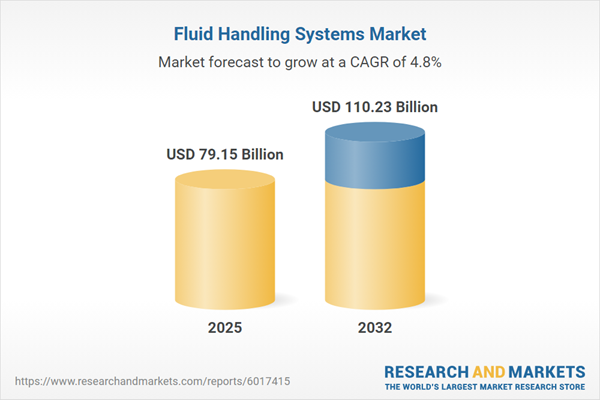Speak directly to the analyst to clarify any post sales queries you may have.
The fluid handling systems market is transforming rapidly as organizations advance digitalization efforts, prioritize sustainability, and adapt to evolving regulatory requirements. Senior decision-makers face the need to anticipate these industry shifts to support resilience and maintain operational performance in a changing global environment.
Market Snapshot: Fluid Handling Systems Market Size and Growth
The global fluid handling systems market is projected to grow from USD 75.56 billion in 2024 to USD 79.15 billion in 2025, reaching a total market size of USD 110.23 billion by 2032. This compound annual growth rate (CAGR) of 4.83% signals continued strength across core industries such as chemicals, food and beverage, pharmaceuticals, mining, and water management. Consistent investment in performance-driven and compliant technologies demonstrates the sector’s ability to accommodate regulatory change, environmental imperatives, and increasing digital automation requirements within modern supply chains. The fluid handling systems market is expected to remain dynamic, as stakeholders pursue reliable and forward-looking solutions.
Scope & Segmentation of the Fluid Handling Systems Market
This report provides comprehensive segmentation and analysis to support effective strategic planning and allocation of resources. Each segment responds to varying technical requirements, compliance challenges, and adoption of new technologies across industry verticals:
- Pump Type: Centrifugal pumps, available in vertical and horizontal models, and positive displacement pumps, including diaphragm, gear, piston, and rotary lobe variants, serve everything from large-scale processes to precision applications.
- Application: Covering chemical processing, food and beverage manufacturing, pharmaceutical production, mining, oil and gas, power generation, and water and wastewater management, each category reflects unique operations, safety, and compliance expectations.
- Drive Type: Diesel engines, electric motors, gas engines, and steam turbines create a suite of energy options tailored to industrial and site-specific needs.
- Material: Systems utilize bronze, cast iron, plastic, and stainless steel to balance durability, regulatory compliance, and lifecycle cost efficiency.
- Flow Rate: High, medium, and low flow system classes offer engineered solutions for process-specific operations and scalability requirements.
- Pressure: High, medium, and low pressure variants provide flexibility to support industrial, municipal, and infrastructure performance parameters.
- Technology: Conventional pump technologies are assessed alongside IoT-enabled smart pumps, which feature sensor integration and predictive maintenance for automated process optimization.
- Distribution Channel: Direct sales, distributor and dealer networks, online and e-commerce platforms, and OEM distribution approaches facilitate market reach and ease of procurement.
- Region: The analysis covers the Americas, Europe, Middle East and Africa, and Asia-Pacific—each representing distinct regulatory, investment, and growth dynamics relevant to both mature and emerging economies.
- Company Coverage: Benchmarking and profiling of key participants such as Grundfos Holding A/S, Xylem Inc., Flowserve Corporation, Sulzer Ltd, Pentair plc, KSB SE & Co. KGaA, ITT Inc., Ebara Corporation, SPX FLOW, Inc., and Andritz AG support competitive analysis and supplier strategy.
Key Takeaways for Senior Leaders
- Investment in digital asset management, through tools like real-time analytics, digital twins, and remote monitoring, is improving uptime and reliability in fluid handling operations.
- Sustainability and regulatory compliance are driving the shift toward more energy-efficient equipment and technology that reduces environmental impact.
- Procurement strategies are adapting by strengthening local partnerships, emphasizing risk mitigation, and maximizing supply chain agility in response to global economic and political shifts.
- Adoption of new materials, modular designs, and additive manufacturing techniques is supporting rapid deployment and customization for industry-specific needs.
- Deepening focus on lifecycle analysis and compliance ensures solutions are aligned with evolving environmental and safety standards in fluid management.
Tariff Impact: Strategic Responses to the 2025 US Tariffs
- The imposition of 2025 US import tariffs on pump and valve components is prompting many manufacturers to diversify suppliers, increase local sourcing, and expand domestic production to control costs and reduce risk of supply interruption.
- Businesses with integrated or localized manufacturing capabilities exhibit greater resilience to tariff price fluctuations, while others are reinforcing inventory management, revising supplier agreements, and improving risk strategies to maintain supply chain continuity.
Research Methodology & Data Sources
The report is based on direct interviews with industry executives, engineers, and procurement specialists, complemented by secondary research from public records, industry reports, and academic studies. Data triangulation validates trends across technologies, end-use applications, and global markets.
Why This Fluid Handling Systems Market Report Matters
- Presents actionable insights for senior leaders to respond effectively to regulatory, technological, and supply chain disruptions shaping the fluid handling systems market.
- In-depth segmentation supports focused investment in growth opportunities, advanced technologies, and markets with high development potential.
- Guides organizations in enhancing supply chain resilience as digitalization and sustainability priorities grow in importance.
Conclusion
This report equips decision-makers with the insights needed to manage industry complexity, identify growth opportunities, and support sustainable operations throughout the increasingly sophisticated fluid handling sector.
Additional Product Information:
- Purchase of this report includes 1 year online access with quarterly updates.
- This report can be updated on request. Please contact our Customer Experience team using the Ask a Question widget on our website.
Table of Contents
3. Executive Summary
4. Market Overview
7. Cumulative Impact of Artificial Intelligence 2025
Companies Mentioned
The companies profiled in this Fluid Handling Systems market report include:- Grundfos Holding A/S
- Xylem Inc.
- Flowserve Corporation
- Sulzer Ltd
- Pentair plc
- KSB SE & Co. KGaA
- ITT Inc.
- Ebara Corporation
- SPX FLOW, Inc.
- Andritz AG
Table Information
| Report Attribute | Details |
|---|---|
| No. of Pages | 183 |
| Published | October 2025 |
| Forecast Period | 2025 - 2032 |
| Estimated Market Value ( USD | $ 79.15 Billion |
| Forecasted Market Value ( USD | $ 110.23 Billion |
| Compound Annual Growth Rate | 4.8% |
| Regions Covered | Global |
| No. of Companies Mentioned | 11 |









